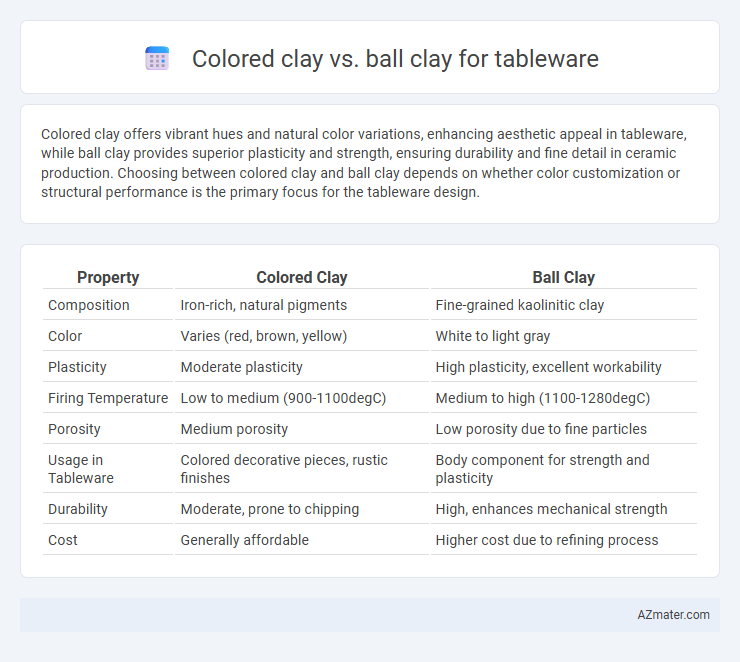Colored clay offers vibrant hues and natural color variations, enhancing aesthetic appeal in tableware, while ball clay provides superior plasticity and strength, ensuring durability and fine detail in ceramic production. Choosing between colored clay and ball clay depends on whether color customization or structural performance is the primary focus for the tableware design.
Table of Comparison
| Property | Colored Clay | Ball Clay |
|---|---|---|
| Composition | Iron-rich, natural pigments | Fine-grained kaolinitic clay |
| Color | Varies (red, brown, yellow) | White to light gray |
| Plasticity | Moderate plasticity | High plasticity, excellent workability |
| Firing Temperature | Low to medium (900-1100degC) | Medium to high (1100-1280degC) |
| Porosity | Medium porosity | Low porosity due to fine particles |
| Usage in Tableware | Colored decorative pieces, rustic finishes | Body component for strength and plasticity |
| Durability | Moderate, prone to chipping | High, enhances mechanical strength |
| Cost | Generally affordable | Higher cost due to refining process |
Introduction to Colored Clay and Ball Clay
Colored clay features natural pigments such as iron oxides and kaolin derivatives that impart unique hues directly to tableware, enhancing aesthetic appeal without the need for surface decoration. Ball clay, composed primarily of kaolinite along with mica and quartz, provides excellent plasticity and strength, making it essential for shaping detailed and durable tableware pieces. The combination of colored clay's visual variety and ball clay's workability allows manufacturers to produce high-quality, visually appealing ceramic tableware.
Key Properties of Colored Clay
Colored clay for tableware is characterized by its unique natural pigments, high plasticity, and moderate firing temperatures, which allow for vibrant, durable finishes without extensive glazing. It offers excellent workability and resistance to cracking, making it ideal for handcrafted or decorative pieces that emphasize aesthetic appeal. Compared to ball clay, colored clay typically has lower particle size fineness but provides better color retention and structural integrity after firing.
Key Properties of Ball Clay
Ball clay exhibits high plasticity and fine particle size, making it ideal for shaping intricate tableware designs. Its strong binding properties enhance the durability and strength of ceramic products after firing. Compared to colored clay, ball clay offers superior whiteness and smooth texture, ensuring a refined finish for premium tableware.
Composition Differences: Colored Clay vs Ball Clay
Colored clay for tableware primarily contains higher amounts of iron oxide and other pigment minerals that provide its distinctive hues, while ball clay features a finer particle size and high plasticity due to its high kaolinite and organic matter content. Ball clay's composition enhances workability and firing strength, making it ideal for shaping and structural integrity, whereas colored clay focuses more on aesthetic appeal with less emphasis on plasticity. These compositional differences impact drying, firing temperatures, and the final texture of tableware products.
Workability and Molding Characteristics
Colored clay for tableware offers excellent workability due to its fine particle size and natural pigments, allowing artists to achieve vibrant, diverse finishes without additional glazing. Ball clay, known for its plasticity and smooth texture, enhances molding characteristics by providing superior elasticity and strength, which facilitates intricate shapes and detailed designs. Combining colored clay with ball clay in tableware production optimizes both aesthetic appeal and structural integrity, improving the overall manufacturing process.
Firing Temperature Comparisons
Colored clay for tableware typically fires at lower temperatures, ranging from cone 04 to cone 06 (approximately 1,060degC to 1,120degC), allowing for vibrant pigmentation retention and reduced energy consumption. Ball clay, in contrast, is often used in higher firing ranges, from cone 06 to cone 10 (1,120degC to 1,300degC), contributing to increased plasticity and strength in stoneware and porcelain bodies. Understanding these firing temperature differences is crucial for selecting the appropriate clay type to achieve desired durability and aesthetic qualities in tableware production.
Aesthetic and Design Possibilities
Colored clay offers a unique aesthetic with natural hues ranging from earthy reds and browns to greens and yellows, allowing designers to create visually striking tableware without additional glazes. Ball clay's fine particle size ensures a smooth, workable texture ideal for intricate shapes and precise detailing, enhancing the finesse of tableware designs but typically requiring added coloring or glazes for vibrant finishes. Combining colored clay's inherent tones with ball clay's plasticity enables innovative design possibilities, striking a balance between natural beauty and functional elegance in tableware production.
Durability and Performance in Tableware
Colored clay offers enhanced aesthetic appeal with its naturally vibrant hues, yet it typically exhibits lower plasticity and durability compared to ball clay, making it less ideal for high-stress tableware applications. Ball clay is renowned for its exceptional plasticity and fine particle size, providing superior strength, durability, and smoother surfaces crucial for functional and long-lasting tableware. The optimal performance in tableware production often combines ball clay's durability with other clays for aesthetic enhancement without compromising the structural integrity of the finished products.
Cost and Availability Considerations
Colored clay for tableware often incurs higher costs due to specialized pigments and limited regional deposits, making it less readily available compared to ball clay. Ball clay offers greater availability with large global reserves and is more cost-effective, widely used for its excellent plasticity and strength in ceramic production. Choosing between the two depends on budget constraints and desired aesthetic properties, balancing expense with functional performance.
Choosing the Right Clay for Tableware Production
Colored clay offers vibrant natural hues ideal for decorative tableware, enhancing aesthetic appeal without excessive glazing. Ball clay provides superior plasticity and strength, ensuring durability and precision in shaping intricate tableware designs. Selecting the right clay depends on the desired finish and functional requirements, balancing color vibrancy with structural integrity for optimal production.

Infographic: Colored clay vs Ball clay for Tableware
 azmater.com
azmater.com